Help as in what color are they? Is there a color match in enamel or acrylic? And lastly… what color would accessories be, like canteens, mess kits, ammo pouches… that sort of stuff.
The basic uniform color was Field Gray. That being said, there was a huge amount of variety in field gray ranging from grayer to bluish or greenish shades. Metal items- canteen cup, gas mask case, mess kits, bayonet scabbards, helmets,etc. could be in a Dark Grey, Dark Green or similar shade. The canteen was covered in a brownish insulating material. Leather gear-belt, catridge cases, suspenders, straps, were usually black. The knapsack/breadbag was canvas of khaki or similar shade. Lots of paint makers market shades that will work.
Vallejo make a good shade of German Field Grey.
Cheers
Mike
Thanks gents. good info.
Trying to define feld grau is like trying to define olive drab. Uniforms weather considerably leading to many different shades of the same basic color. Blouses and trousers can after a few months appear to be different colors evan if they were issued at the same time. Then you throw in different manufacturers, years, etc., and it gets really interesting. If you put a bunch of troops together with all of their uniforms exactly the same shade of color it don´t look right. For Eighth and I maybe but not for the FMF. Stickpusher has the Ducegear right but there could also be brown leather (Afrika Korps or Fallschirmjager), or kaki green or brown for Mag pouches and web gear in the later war years. But I dont think I`ve seen kaki Kar 98 or leather Mp44 pouches.
Regards, Mac
Here is a good example of field grey as I have interpreted it (the blouse and cap on the officer on the right…note that his trousers have a bluish tint to them that seemed common early in the war for officers):
Here is another good shot of a German in full field-grey (pointing figure):

Some variations in field grey color in the SS winter smock:
Panzergrenadiers in field-grey and full assault kit: 
Field grey trousers on these SS types:
Field grey overcoat on SS officer: 
Humbrol makes a fine field-grey…I’ll try to post some Osprey plates over the weekend made by Ron Volstad that I feel are the “gold standard” in accurate shades for uniforms and kit…
Field grey (Feldgrau) Heer (Army) should have a distinct tint towards the olive green, sort of a dark gray-green… As the war progressed, dyes were of poorer quality, causing rapid fading, and the fabric became less color-fast as the amount of celulose (read: paper) was increased. All kinds of feldgrau shades are common, but retain the greenish hue. Waffen-SS uniforms are a lighter shade of grey, mouse grey, (Mausgrau) that has a shift towards blue. I prefer Tamiya Feldgrau, seems to match up best with my German uniforms.
Heer and Waffen-SS Stalhelme (steel helmets) are in a varity of shades of feldgrau or panzergrau, depending on the model, early war were in high-quality finishes, with any old shade gray or gray-green in the later years, as well as less and less steel actually going into the helmet. Luftwaffe helmets were a standard medium blue-grey, with the exception of Luftwaffe Field Divisions and Fallschirmjager, which were various shades of feldgrau…
Suspenders, belts, MP-40 mag pouches (if leather) and k-98 ammo pouches were black leather, brown for Luftwaffe. The breadsacks are a mouse grey or field grey fabric, as are the straps for them (you will sometime see the straps used as camouflage bands on helmets). The canteen covers are a reddish-brown wool felt for most troops, the exception being that medical troops were issued ones in a dark grey wool felt, meat cans, canteen cups, and gas mask carriers were dark green (some cups were black), but chipped easily, showing the metal. Bayonet grips and scabbards are black, e-tool blades dark green.
Belt buckles are medium grey-green (not on walking-out uniforms, though), but most had their finishes worn off in the field, troops would re-paint them with whatever dark color was on hand.
Here’s some shots of me and a few fellow Soldaten in character at some WW2 events:

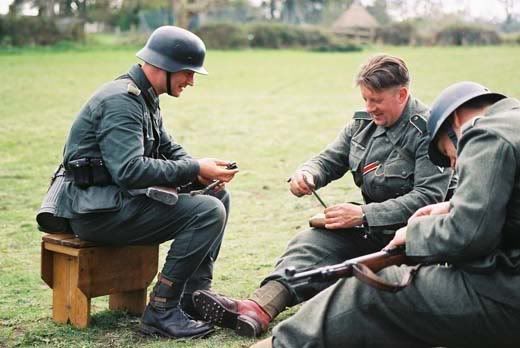
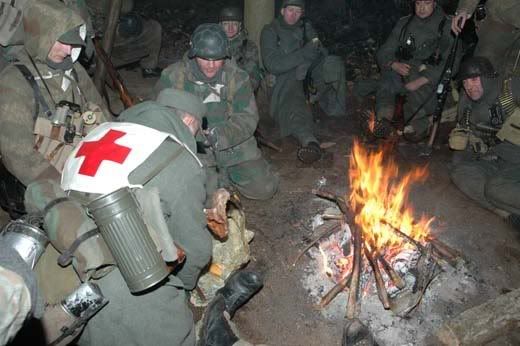
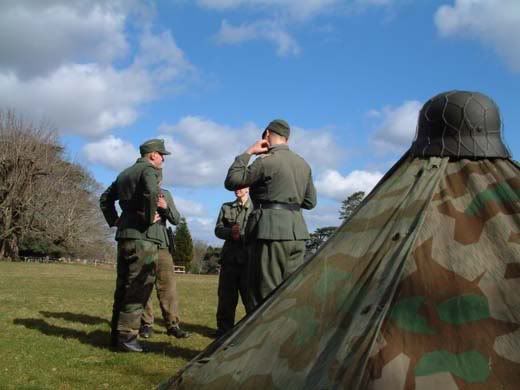
Hans,
Sorry about the [#offtopic]
Have you ever had any negative or bad experiences while doing your re-enacting ? Knowing how some misguided souls see anything connected with the Axis as being “evil”, I wondered whether you had ever copped any flak from outsiders. Or do you guys do your stuff in a fairly isolated area ? I remember when I got back into modelling, my in-laws rolled their eyes and made several comments about swastikas being displayed on My Ju-87, Me109, Fw-190. I guess for their generation (mid 70’s) The swastika will always have evil connotations.
Wirraway, this is gonna be a long answer…[8D] I and other Soldaten get the “Why a Nazi?” question from folks at living history events all the time and this is how I explain it. We’re simply a group of amature military historians trying to accurately portray what the German Soldier looked like and what he was equipped with. Many of them have seen “Band of Brothers” and I use the scene in the movie (when the British troops were dressed as Germans, wandering around the airfield, giving the American paratroopers a good look at what German troops looked like, since even in June 1944, most American troops taking part in Overlord had never seen a German other than in black & white photos) to describe what we’re doing, that it’s all about educating, not idolizing or being political. It’s simply the way it was…
I can tell you that you can’t help feeling a greater sense of self-consciousness when you are at an event dressed as a “Nazi” because the majority of the people in the world view you as just that - a Nazi… the embodiment of evil in the 20th century. But, for those of us who study the subject, we know that the average German soldier was not unlike his Allied counterpart. The German soldier was a man called about to do a job. He had not made this war come about, nor was he a political fanatic. He was well disciplined, obeyed his orders and fought bravely. Toward the end of the war he became disillusioned, but nevertheless he did his duty well. If displeased, the German soldier was not inclined to revolt. In defeat, the German soldier retained his pride and self esteem. Even when his country lay in ruin, every man a prisoner and the people of his nation refugees, and he knew that he had belonged to what was once considered the best armed forces in the world.
In the end, the German soldier realized that he had fought for the wrong ideals and the wrong causes. He was misled by the leaders into which he had placed his trust. He was ashamed of the atrocities. He was trapped in history as an instrument of war. Nevertheless, he remained true to his sworn oath, “For Fuhrer and Fatherland”.
I think Bill Mauldin said it best (during the war). He said, "Folks back home will say, “It’s not the Germans, it’s the Nazis! You’ll never hear a Dogface say, ‘Those dirty Nazis!’ when he’s talking about Germans. He’ll say, ‘Godd*mn Krauts…’. You may hear a GI call a German a skunk, but you’ll never hear him say he’s not good.”…
I also explain that Swastika was not the symbol of the Wehrmacht, but rather the German national symbol and that the German soldier had no more control over that than an American GI has over the US Great Seal. EDIT: I misspoke in this thread about the Oath to Adoph Hitler. The Wehrmacht troops did swear aligiance to Hitler as well as the Fatherland, much the same way that the US Oath of enlistment states that you “will obey the orders of the Commander-in-Chief”.- HvH
As for the German units that are portrayed, we’re very selective about who joins. If we get even a wiff that an individual wants to do it because he’s some kind of Skinhead, white supremist, “militia”, Neo-Nazi dirtbag, it’s, "thanks for your interest, now “Raus mit Dich!”… Even if some sneak in, they get found out rather quickly. (If you got a Swastika tattoo, you can forget it, but we do allow Waffen-SS actors to have temporary tattoos of blood-type inside the left upper arm for authenticity) We don’t allow any SS units (other the Waffen-SS) either… Allgemeine-SS, SS-Polizei, SS-Verfügungstruppe, SS Ordnertruppen, SS-Totenkopfverbände, party (brownshirts), Hitler Jugend and Gestapo uniforms may be displayed, but not worn. Same goes for the Nazi Party flag. Battle flags may be displayed, but not flown, and all battle flags must be used only for ID on vehicles, tied down on the top-side of them for recognition flags. Our unit flags have the Balkenkreuze in place of the Swastika.
For the battles, we do have both public and private events. In the WW2 HRS by-laws, Germans MUST “lose” every battle that’s open to the public (After a good fight, of course). In the private, members-only events, that restriction doesn’t apply. (Since air superiority doesn’t apply, the Germans actually can whip some butt) I recall one time that for a battle out in Nebraska, our assembly area was several miles from the battlefield at Camp Ashton, Nebraska and we had to get transported to the area, and it took us through town. We got some funny looks from folks, and there were a couple of elderly gents that REALLY gave us the eye when we were stopped at a light in town… 'Course, we were in full German uniform, riding in a Blitz with full tactical markings, but that’s another story…[:D]
On a side-note, my late father-in-law was captured in France in 1944 (He was in a Luftwaffe flak unit) and spent the rest of the war in Camp Swift, Texas. He returned to the States in 1958 and passed away in 1997 in San Antonio. At the same time, my father was a fighter pilot (55th FG, 343rd FS) so it was plausible that my father-in-law shot at my Dad… (They got along quite well even so)
Overall though, most folks “get” what we’re doing, those that don’t we try to help understand… At least the ones that will talk with us, that is…
That is most interesting!
Hans-
I don’t post much here, but I wanted to say thank you for posting the pics, and for taking the trouble of explaining why people are German reenactors (or, are any kind of reenactor, I suppose).
You’re definitely into it for the right reasons! To me, “living history” allows those of us who are interested spectators a unique perspective into the past, that no other source can quite offer. Looks like your group does an outstanding job of it!
Hans, just a side question, but how many of your fellow re-enactors would you say are military veterans? A small or high percentage? I am just curious. During my service, especially in the Guard, I would say that many soldiers I met have a similar historical interest, but only a very few were re-enactors. Collectors of memorabilia though were more numerous.
Getting back to the original topic, dark grey, as opposed to field grey, trousers were widely worn in the early years of the war, though field grey took over as the war progressed. Officers, especially senior ones, often wore dark grey trousers pretty much throughout the war.
This is a huge topic, and if you’re going to make more than the occasional Wehrmacht figure, you really do need to invest in at least a couple of books on the subject. German Army Uniforms and Insignia 1933-1945 by Brian L Davis, though first published over 35 years ago, is a good single-volume starting point, and, though I think it’s out-of-print at the moment, can be found cheaply secondhand:
In the Humbrol range, Hu.102 Army Green is quite a good starting point, though I usually spray the main uniform colour on my figures, and for that, Tamiya XF65 Field Grey is good. The fact that the two colours are significantly different illustrates the point that others have made about there being wide variation in shades.
Cheers,
Chris.
Again thansk for all the great info.
Wing_nut, these pics may help you. I took them at the Ft. Lewis museum in Washingtoon state.

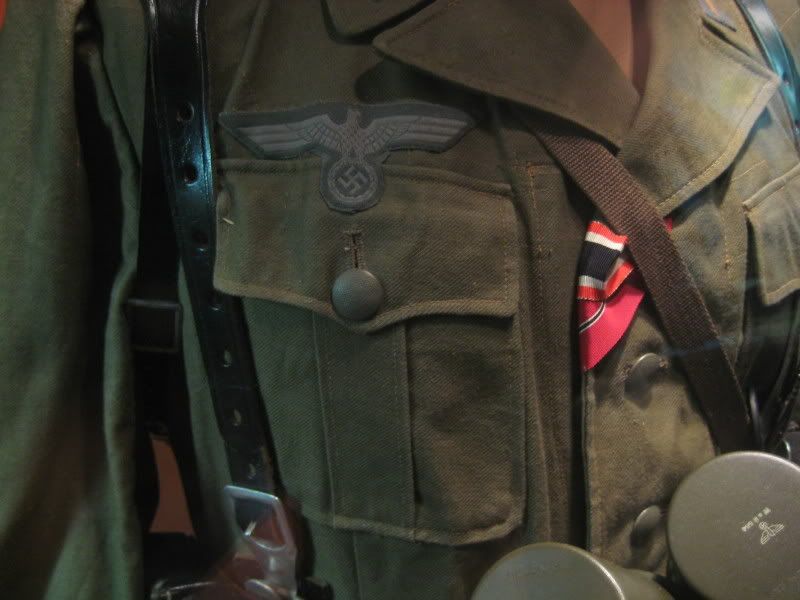
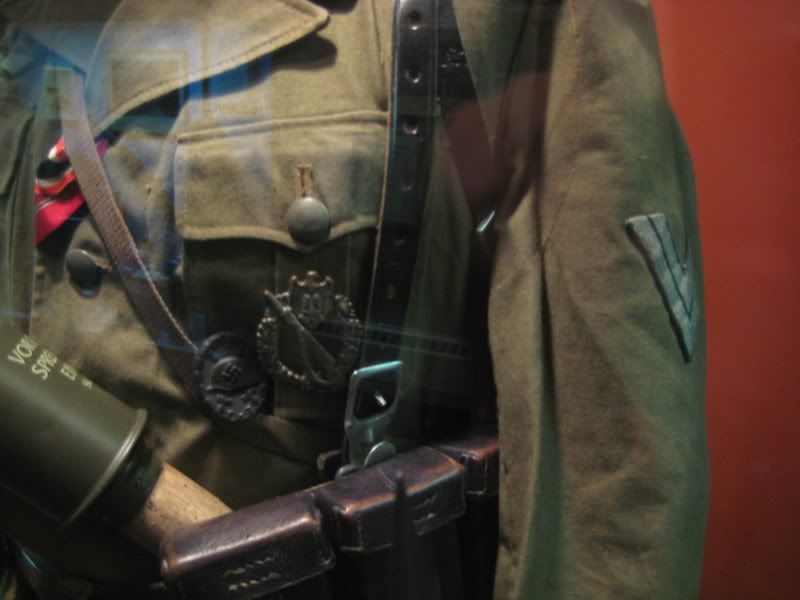
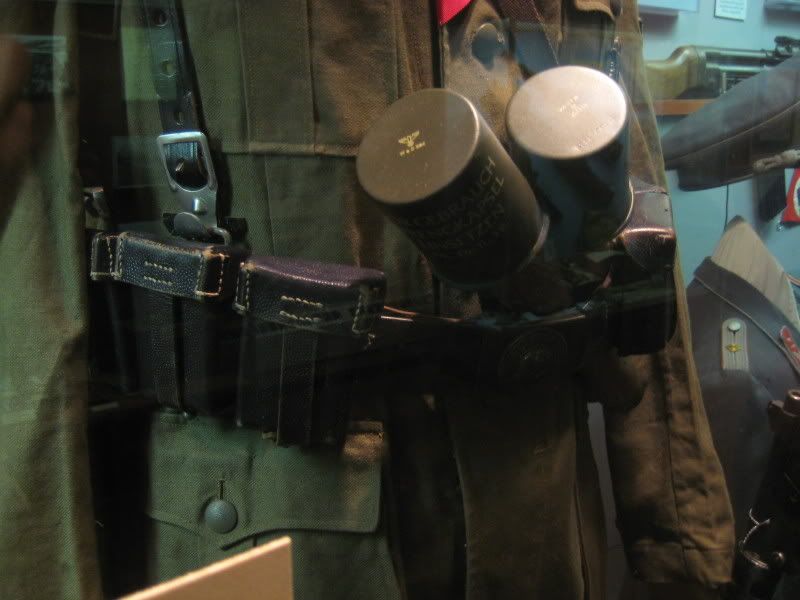
The placard on the display stated that this was a grenadier uniform from 43. I have other pictures of weapons, badges etc if you need anything else.
Erik
more off topic…lots of reenactors coming to Michigan next weekend
Here is a pic from my personal collection. Taken at the WWII Victory Museum in Auburn, IN.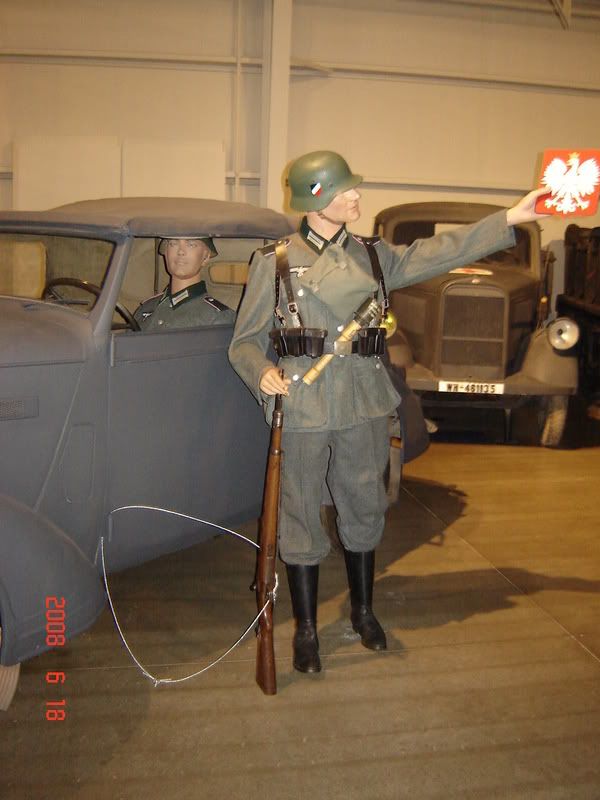
The actual numbers of vets in the units I’m around (352 Infanterie, my unit-1 Kompanie 343 Infanterie, 2 Panzer, Gross Deutchland, and FJR 4) are fairly small. Most vets I know are just collectors or Civil War reenactors. The Civil War guys seem to have the largest number of US Military vets, especially among officers. Oddly, Fallschirmjager Regiment 4 seems to be almost entirely active duty USAF and Air Guard. The other unit I reenact with, 918th Bomb Group (H), is almost all Army veterans. Go figger…
Keeping on-topic, I found that when I started reenacting, a lot of reference material on uniform colors geared towards the modeler was way off, especially the stuff from Squadron/Signal… (They covered it by stating that actual colors depended on dates of issue, material used and color-fastness of dyes used and . No kidding…) It’s still a builder’s call on what looks “right”…
The main problem with matching colors of the real stuff to minatures is “scaling” the colors… Most model paints matched up to the uniforms run a bit dark once they’re on a figure, in my opinion. One thing you may want to try, is that by mid-war, most German Heer helmets had toned-downed finishes. The satin finish prevailed in the early war years, but came with rough finishes by 1943. Try painting the helmets with the color you want, then dip it in baking soda to texture the finish and paint it again.
There was also a lot of Italian camo material that was used by the Germans after Sicily and there were a lot of Italian/German fabric mixes on uniforms. If you’re modeling units in Italy, you can add a bit of variety that way.
Thanks for all the info Hans! I can only imagine the reactions you get from some people. I was reading the book In Deadly Combat, which is about German soldiers on the Eastern Front, at work once. I had one guy give me a funny look as if to ask why would you read such a thing. I had to explain to him that not every German soldier was an atrocity commiting Nazi. I don’t think I convinced him.
I dont recall any member of our group being from Iowa?
The photos that you are trying to pass off as yours are of 5 Kompanie,Grenadier Regiment 916 a U.K based reenactment group, which I am a member…and your not?..
Wing, theres a good show in Pa. around D-day. At the Mid Atlantic Air Museum,www.maam.org. They have re-enactors and a battle there plus a huge air show modern and vintage.And a huge flea market area I have been going every year for the last 5-6 years its not far from us about 2 hours tops parking is bad but they have bus transports. Plus a lot of WW-2 vets there for autographs( the Enola Gays navigator was there 2 years ago, R Lee Ermy was there to one year I had to get his autograph lol…Hope this info helps.Did you ever do anything with the bed of your pick up?
John
J